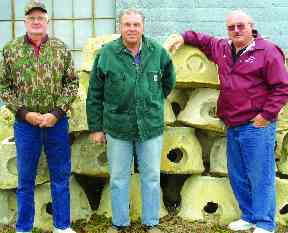|
Published: Feb 02, 2007 - 09:55:41 pm
EST
Buying a ton for the
Bay
By Renee Gilliard, Daily
Banner
 |
| Maryland Saltwater Sportfishermen's
Association members Phil Todd, left, Bob Geisler and
president Clint Waters show the concrete reef balls
their organization has used to create marine habitats
around the Choptank River and in the Chesapeake Bay.
Daily Banner/Renee Gilliard
|
CAMBRIDGE - The Maryland Department of Natural
Resources made plans to purchase chunks of the Woodrow Wilson
Bridge in order to improve the Chesapeake Bay.
On the
Potomac River, a 7 1/2 mile stretch including the 6,075 ft.
bridge is being reconstructed at a cost of $2.5
billion.
The ambitious six-year renovation extends into
next year when both of the two replacement bridge structures
will be complete. From the demolition, the previous bridge has
yielded tons of concrete chunks of which the Maryland
Saltwater Sportfishermen's Association and Maryland DNR have
discovered has a beneficial aquatic purpose.
The MSSA,
along with the DNR and the Chesapeake Bay Foundation, began a
local artificial reef installation plan when they placed
eighty concrete reef balls into the Choptank River near
Hambrooks Bar.
With concrete donated by Barnett
Concrete and molds from Composite Yacht, the MSSA produced
120-pound blocks of concrete perforated with 4 to 8 inch
holes, known as reef balls.
Mid-Shore Electronics also donated storage space
for the completed reef balls. These concrete reefs provide
hard, porous surfaces on which organisms such as oysters or
truncates attach themselves. Fish are therefore attracted to
the reef to feed and for their own shelter, providing a rich
fishing area.
When Dorchester County MSSA president
Clint Waters heard about the bridge demolition, he was excited
by the opportunity to further improve the local fishing
industry.
"I thought this was really a
once-in-a-lifetime opportunity, because these artificial reefs
create a habitat for a lot of marine life. That bridge is
producing tons of reef material," Mr. Waters said.
MSSA
plans to contribute to the Maryland Artificial Reef
Initiative, a collaboration of more than thirty partners,
which focuses on using the surplus concrete from the
demolished bridge to create at least a dozen reefs throughout
the Bay. Plans to develop reef sites are already under way,
including local fishing spots around James Island and a 1944
WWII seaplane wreck in the lower Choptank.
The first
reef site to benefit from the old bridge was an existing reef
at Point No Point in St. Mary's County last summer. Nearly
4,000 tons of concrete was added to the existing artificial
reef.
Benthic (water-bottom) communities consisting of
mussels, algae, barnacles and oysters have already begun to
grow on concrete chunks and local fishermen have reported
considerable catches just weeks after the placement. This type
of operation, however, can be costly. Transportation of the
material from the demolition site to the Point No Point reef
site cost the DNR $38,000.
More concrete is available
for the other planned Bay sites, but funding remains a
problem.
Though the MARI promises improvement in the
sport fishing industry and benthic ecology, and bridge
contractors are willing to share costs with the DNR, the DNR
estimates the success of this project will still cost $800,000
for material transport. To solve the financial support
problem, the MARI has opened funding to donors. Anyone who
supports the initiative can finance the transportation of one
ton of the old Woodrow Wilson Bridge to an artificial reef
site for a $25 donation.
The MSSA will hold a public
interest meeting Feb. 15 at the Cambridge American Legion at
7:30 p.m., when representatives from the Chesapeake Bay
Foundation will present information on the
MARI.
Interested donors may send checks payable to CCD
MD Reef Fund, MSSA Office, 8461 C Fort Smallwood Road,
Pasadena, MD 21122, or log on to www.ccamd.org.
|


